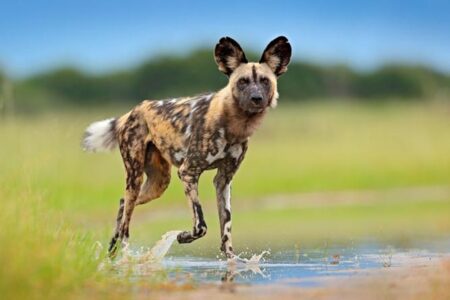
10 Facts About the African Wild Dog (One of the World’s Most Endangered Mammals)
The African wild dog, also known as the Cape hunting dog or painted wolf is one of the world’s most endangered mammals with a population of only about 6,600 in the wild and they are a rare and fascinating species.
Native to Africa, these canine predators are known for their unique coat patterns and fierce hunting abilities and they are social animals who live in packs and are highly intelligent, with a remarkable ability to coordinate their hunting and communication.
Notwithstanding their unique characteristics and importance to the ecosystem, African wild dogs are facing threats from habitat loss, hunting, and diseases.
Overview of African Wild Dog
African wild dogs, also known as painted wolves or Cape hunting dogs, are the second-most endangered carnivore in Africa after the Ethiopian wolf and they are native to sub-Saharan Africa, with their population mainly located in eastern and southern Africa.
African wild dogs are large, distinctive predators with long, lean bodies, large ears, and a bushy tail. Their coat is typically covered in irregular blotches of black, brown, yellow, and white, which gives them their name of “painted wolves”. These dogs are incredibly social animals living in packs of up to 30 individuals.
10 Facts About the African Wild Dog (One of the World’s Most Endangered Mammals)
Here are 10 fascinating facts about African wild dogs:
1. They have one of the highest success rates for hunts among all African predators, with a success rate of up to 85%.
The success rate of 85% is largely due to the African wild dog’s hunting strategy and teamwork.
Here’s a summary of how this works:
When the pack identifies a prey animal, they will surround it and chase it until it becomes exhausted. Then, one or two dogs will hold the prey down while the others attack. This strategy is highly effective and allows the pack to take down prey that is larger and faster than themselves.
This teamwork and hunting strategy is what gives the African wild dog a high success rate compared to other predators in Africa.
2. African Wild dogs are highly social animals, living in packs of up to 30 individuals.
African wild dogs are highly social animals that live in packs of up to 30 individuals and this allows them to benefit from cooperative hunting, protection from predators, and effective communication. Their social interactions include affectionate grooming and play, as well as cooperative care of their young.
3. They are the second-most endangered carnivore in Africa after the Ethiopian wolf, with only around 6,600 individuals remaining in the wild.
African wild dogs are the second-most endangered carnivores in Africa because their population has declined rapidly in recent years. This is largely due to human activities that have reduced their habitat, spread disease, and led to conflicts with livestock.
As a result of this, around 6,600 African wild dogs remain in the wild, and the species is in danger of becoming extinct.
Because of their vulnerability, African wild dogs are listed as endangered by the International Union for Conservation of Nature (IUCN).
4. They are extremely fast, with speeds of up to 60 kilometers (37 miles) per hour.
African wild dogs are incredibly fast and agile animals, which helps them to survive in the wild. Their speed allows them to hunt prey, evade predators, and travel long distances to find food.
The speed of African wild dogs is made possible by several factors:
- Physical Adaptations: African wild dogs have a lean and muscular body that is well-suited for running. They also have a flexible spine and large lungs that allow them to run for long periods without tiring.
- Adaptive Behaviors: African wild dogs use their speed to their advantage in several ways. For example, they can run down prey that is faster than them, such as antelope, by using their endurance and persistence.
- Hunting Strategy: African wild dogs are also known for their cooperative hunting strategy, which allows them to surround their prey and trap it using their speed and agility.
5. African wild dogs use a complex system of vocalizations like barks, howls, and chirps, to communicate with each other.
African wild dogs have a highly developed system of vocalizations that allow them to communicate with each other in a variety of situations. Some of the vocalizations used by African wild dogs include:
- Barks: African wild dogs use a variety of barks to communicate with each other, including alarm barks, hunting barks, and greeting barks.
- Howls: African wild dogs use howls to communicate over long distances and to locate other members of their pack.
- Chirps: African wild dogs use a chirping sound to communicate with each other during play and when greeting each other.
- Whimpers: African wild dogs use whimpers to express a range of emotions, including fear, submission, and excitement.
- Growls: African wild dogs use growls to express aggression and to warn off other animals.
6. They are highly intelligent and cooperative hunters who use strategies like encircling their prey to increase their chances of success.
African wild dogs are highly intelligent and cooperative hunters who use several strategies to increase their chances of success like encircling their prey. This encircling strategy requires the dogs to work together as a team and to communicate with each other using vocalizations and body language.
The intelligence and cooperation of African wild dogs are also evident in other hunting strategies like using distractions to confuse their prey and cooperating to take down larger prey.
These hunting strategies are a testament to the African wild dog’s intelligence and cooperative nature and that has allowed them to thrive in the wild for millions of years.
7. African wild dogs are loyal to their pack, with the entire pack often working together to care for the young and defend their territory.
African wild dogs are highly social animals that live in packs of up to 30 individuals and these packs are tightly-knit and highly cooperative, with every member playing an important role in the survival of the pack.
One of how this cooperation is evident is in the care of the young. African wild dogs have a complex system of care for their young, with different members of the pack taking on different roles. For example, the alpha pair (the dominant male and female) will provide food for the young, while other members of the pack will protect them from predators and help to socialize them.
SEE ALSO: Why Do Dogs Roll In Dirt after a Bath?
Why are African Wild Dogs Endangered?
African wild dogs are one of the most endangered mammals in Africa due to a variety of factors, including:
- Habitat Loss: African wild dogs have lost much of their natural habitat due to human activities such as agriculture, urban development, and logging. This has reduced their range and the prey that they depend on for survival.
- Human-Wildlife Conflict: African wild dogs are sometimes considered a threat to livestock, which has led to hunting, trapping, and killing of these animals.
- Disease: African wild dogs are vulnerable to several diseases, including rabies, distemper, and canine parvovirus. These diseases can have devastating effects on wild dog populations.
- Fragmentation of Populations: African wild dogs have been pushed out of much of their former range, which has led to the fragmentation of their populations. This makes it difficult for them to find suitable habitat and breeding partners.
These factors along with other human-related threats have led to the decline of African wild dogs in the wild and made them one of the most endangered carnivores in Africa.
African Wild Dog vs Hyena
African wild dogs and hyenas are both large carnivores that are native to Africa. Here are some key differences between these two species:
- Hunting Strategies: African wild dogs are cooperative hunters who use strategies like encircling their prey and using distractions to increase their chances of success. Hyenas, on the other hand, are scavengers and opportunistic hunters who will steal kills from other predators or hunt in small groups.
- Social Structure: African wild dogs live in packs of up to 30 individuals, with a complex social hierarchy and cooperative behavior.
- Diet: African wild dogs primarily prey on antelope, but will also eat other mammals, birds, and reptiles. Hyenas are more opportunistic eaters and will consume a wide variety of food items, including carrion, rodents, and even fruit.
- Intelligence: African wild dogs are highly intelligent animals that use complex communication and cooperation to hunt and survive. Hyenas are also intelligent, but their social behavior is less complex, with groups of hyenas often fighting over food and territory.
African Wild Dog Speed km/h
African wild dogs are incredibly fast animals, with speeds of up to 60 kilometers (37 miles) per hour. This speed is achieved through several factors, including:
- Lean Body: African wild dogs have a lean and muscular body that is well-suited for running at high speeds.
- Long Legs: African wild dogs have long legs that allow them to cover long distances quickly.
- Flexible Spine: African wild dogs have a flexible spine that helps them to change direction quickly while running at high speeds.
SEE ALSO: 60 Facts About Dogs You Might Not Know
FAQs
Q. How are African wild dogs endangered?
African wild dogs are endangered due to habitat loss, human-wildlife conflict, and disease. These factors have led to a rapid decline in their population and made them one of the most endangered carnivores in Africa.
Q. What’s the most endangered wild dog?
The Ethiopian wolf, also known as the Simien jackal, is considered the most endangered wild dog species in the world. With only about 500 individuals left in the wild, they are critically endangered and face a high risk of extinction. Ethiopian wolves are found only in the highland regions of Ethiopia, and they are threatened by habitat loss, human-wildlife conflict, and disease.
Q. How many African wild dogs are left?
Currently, fewer than 7,000 African wild dogs survive in the wild, and only 1,500 of these are adults. It is thought that just 700 packs of wild dogs remain, scattered across the entire continent.


